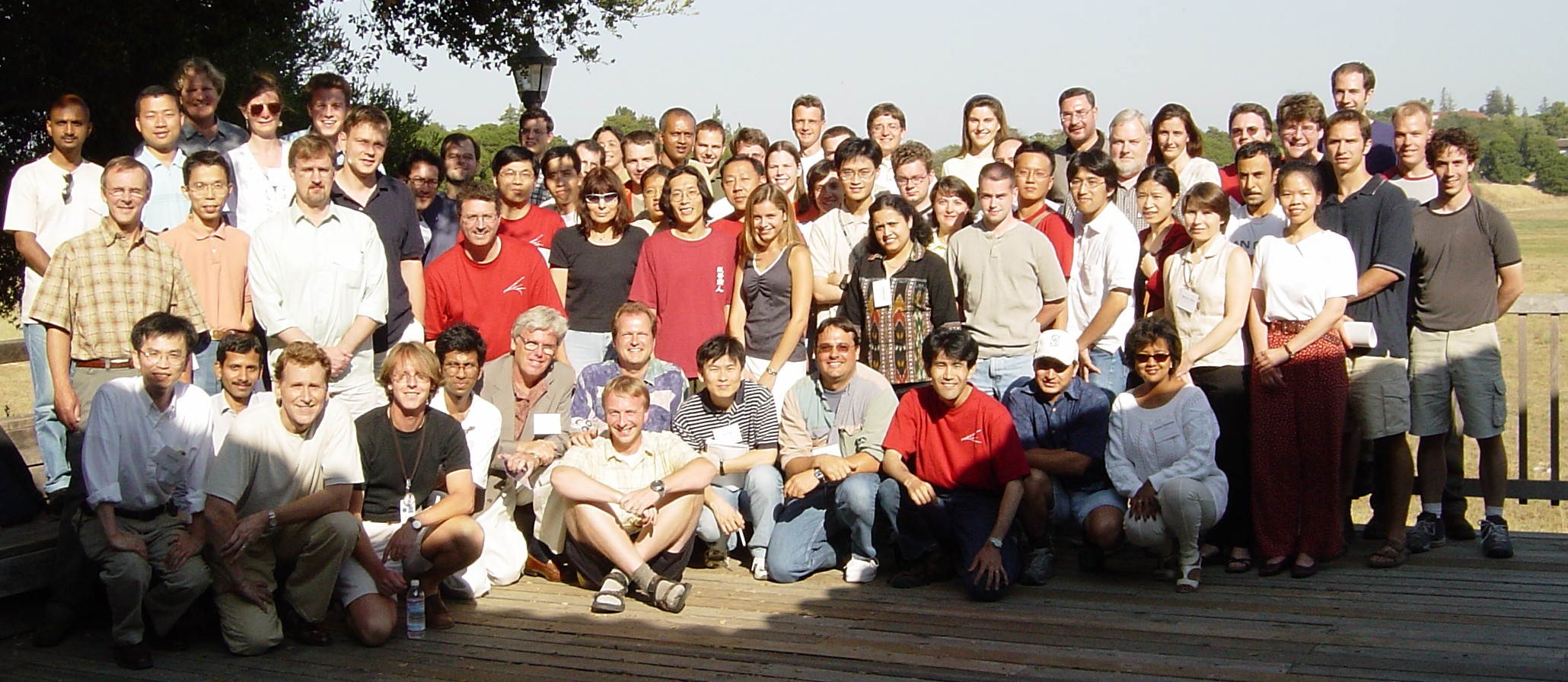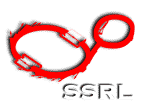
| Home | 2000 | 2001 | 2002 | 2003 | 2004 |
SMB Summer School 2002: July 7-12, 2002 |
Table of Contents |
Summary
The Stanford-Berkeley Summer Schools are jointly organized by Stanford University, University of California Berkeley, Lawrence Berkeley National Laboratory, and the Stanford Synchrotron Radiation Laboratory. The Summer School series provides lecture programs on synchrotron radiation and its broad range of scientific applications in the Physical and Life Sciences. The goal of the school is to disseminate information about scientific opportunities in synchrotron radiation applications and train students on experimental techniques. It provides an interdisciplinary and intellectually stimulating environment for new and experienced researchers. Interaction between lecturers and students is stimulated through dedicated problem solving sessions and round table discussions.
The Summer Schools 2002 attracted 68 students from various parts of the world. This year's program in the Life Sciences focused on structure determination methods in macromolecular crystallography from crystal screening to structure interpretation with special emphasis on computational methods. The Physical Sciences program provided a comprehensive overview of the synchrotron radiation process and its applications related to spectroscopy and diffraction. Particular emphasis was given to examples from physics, chemistry, and material science.

Joint Sessions
The program started with a joint session on Monday morning that emphasized synchrotron radiation generation, interaction of synchrotron radiation with matter and the details of insertion devices and beam lines with a focus on new technologies. The speakers for this session were Dave Attwood (UC Berkeley), Anders Nilsson (Stanford Univ.), and Peter Kuhn (Stanford Univ.). These lectures provided an overall picture of synchrotron radiation and its future role. Friday's joint session started with a lecture by Helmut Wiedemann on "Electron accelerators as synchrotron radiation sources". This was followed by a tour of SSRL's storage ring, the macromolecular crystallography, material science, and x-ray diffraction beam lines. Participants had the opportunity to take a close look at one of SSRL's sample changing systems, which was in production at the macromolecular crystallography beamline 11-1. Afternoon lectures by Douglas Rees (California Institute of Technology) on "Crystallography at the cutting edge", Jim Wells (Sunesis Pharmaceuticals) on "Drug development", and Joachim Stohr (Stanford University) on "Industrial applications of synchrotron radiation" gave an exciting overview of the importance and opportunities of synchrotron radiation in applied research.
Life Sciences Program
A total of 40 students enrolled for the Life Sciences program. Thirty-two students were from the US, six from Canada, one from Singapore, and one from Taiwan. Programs provided a very stimulating environment leading to good interactions between students and speakers. There were also special sessions encouraging students to present their problems for discussion. Thirteen of the lecturers were from the US, two from the UK, and one from Germany. Details of the program and background on the speakers can be found on the web at http://smb.slac.stanford.edu/SR-School/ls2002prog.html. A satellite workshop on "Integrated Software for Structural Genomics and High-Throughput Structural Biology" was held on Tuesday and Wednesday evening and included presentations and discussions concerning crystallographic software automation, beam line automation, and related software development issues. A follow-up brainstorming session on Wednesday evening gathered ideas from students and speakers on future automation requirements. A more detailed description of the program can be accessed from the main program website.
The Monday afternoon session started with a lecture on "Crystallography understanding the baseline" by Tom Alber. This was followed by a lecture by Elspeth Garman on "Diffraction theory and space groups". The evening session was devoted to student problems. Students were encouraged to present issues related to their current research. During the discussions following each presentation all participants shared experiences and suggested various ways to solve the problems.
Principles of data reduction, phasing, refinement, and model validation were discussed during the Tuesday morning session. These lectures were followed by tutorial-cum-lecture sessions on diffraction data assessment, heavy atom substructure and alternative derivatives. Speakers for these sessions were Andrew Leslie, Axel Brunger, Elspeth Garman, Ana Gonzalez, Thomas Schneider, and Paul Ellis.
The Wednesday sessions started with lectures on high throughput structural biology and practical aspects of data reduction by Ashley Deacon and Andrew Leslie, respectively. This was followed by tutorial-cum-lecture sessions by Thomas Schneider, Andrew Leslie and Leslie Tari on practical aspects of solving heavy atom substructures, phase improvement, and problems in model building and fitting. Paul Adams gave a detailed lecture on the principles and other issues related to the automation of refinement.
Lecture Materials
Participants
Organizers
|
Tutors for the school
| Paul Adams | PDAdams@lbl.gov | LBL & Berkeley |
| Tom Alber | tom@ucxray6.berkeley.edu | UC Berkeley |
| Dave Attwood | dtattwood@lbl.gov | UC Berkeley and LBNL |
| Sean Brennan | bren@ssrl.slac.stanford.edu | SSRL |
| Gordon Brown | gordon@pangea.stanford.edu | Stanford |
| Axel Brunger | axel.brunger@stanford.edu | Stanford |
| Ashley Deacon | adeacon@slac.stanford.edu | Stanford |
| Paul Ellis | ellis@slac.stanford.edu | Stanford |
| Charles Fadley | fadley@lbl.gov | UC Davis and LBNL |
| Elspeth Garman | elspeth@biop.ox.ac.uk | Oxford University |
| Graham George | ggeorge@slac.stanford.edu | SSRL |
| Ana Gonzalez | ana@slac.stanford.edu | Stanford |
| Jerry Hastings | jbh@slac.stanford.edu | SSRL |
| Charles Kissinger | crk@stromix.com | Structural Genomics |
| Andrew Leslie | andrew@mrc-lmb.cam.ac.uk | MRC Cambridge |
| Irimpan Mathews | iimathew@slac.stanford.edu | Stanford |
| Tim McPhillips | tim@slac.stanford.edu | Stanford |
| Duncan McRee | dmcree@syrrx.com | Syrrx |
| Anders Nilsson | nilsson@slac.stanford.edu | SSRL & Stockholm University |
| Anastassis Perrakis | perrakis@nki.nl | NKI Amsterdam |
| Doug Rees | dcrees@caltech.edu | Caltech |
| Andrej Sali | sali@rockefeller.edu | Rockefeller University |
| Thomas Schneider | trs@shelx.uni-ac.gwdg.de | Univ. of Göttingen |
| Z.-X. Shen | shen@ssrl.slac.stanford.edu | Stanford |
| Neville Smith | nvsmith@lbl.gov | LBNL |
| Jo Stöhr | stohr@ssrl.slac.stanford.edu | SSRL & Stanford University |
| Leslie Tari | leslie.tari@syrrx.com | Syrrx |
| Frank von Delft | Syrrx | |
| Tony Warwick | t_warwick@lbl.gov | LBNL |
| Jim Wells | jaw@sunesis.com | Sunesis |
| Helmut Wiedemann | wiedemann@ssrl.slac.stanford.edu | SSRL |
The 2002 Summer School is financially supported by:
 |
||
| Celera |
Chiron
Pharmaceuticals | |
 | ||
| ADSC |
Syrxx | |
 |
 | |
| NIH-NCRR |
SGX | |
 |
 | |
| Gammadata
Scienta |
Advanced Light
Source | |
 | ||
| SSRL | ||